CBSE Class 12 Physics Chapter 5 Magnetism And Matter Multiple Choice Questions And Answers
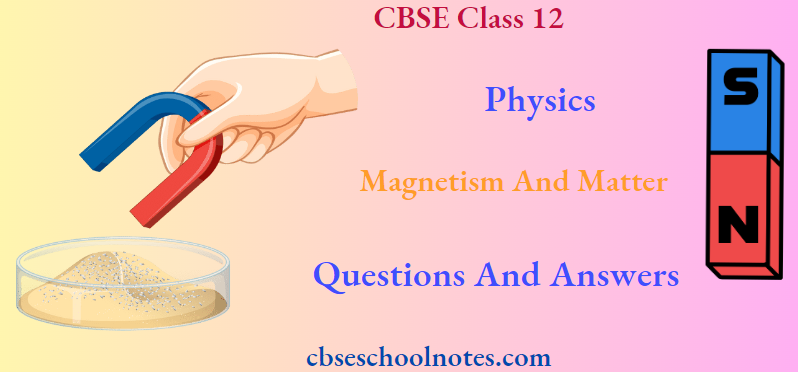
Question 1. The vertical component of the earth’s magnetic field at a place is \(\frac{1}{\sqrt{3}}\) times the horizontal component. The angle trip of dip at that place is:
- 0°
- 30°
- 45°
- 60°
Answer: 2. 30°
Read and Learn More Important Questions for Class 12 Physics with Answers
Question 2. Inside a bar magnet, the magnetic field lines
- Are not present
- Are parallel to the cross-sectional area
- Are in the direction from N-poIcs to S-pole
- Are in the direction from S-pole to N-pole
Answer: 4. Are in the direction from S-pole to N-pole
Question 3. A magnetic needle is kept nonparallel to the magnetic field in non-uniform magnetic field experiences.
- A force but not a torque
- Torque but not a force
- Both a force and a torque
- Neither a force nor a torque
Answer: 3. Both a force and a torque
Question 4. When a paramagnetic substance is brought near a north pole or a south pole of a bar magnet, it __________.
- Experience repulsion
- Docs do not experience attraction or repulsion
- Experience attraction
- Experience attraction or repulsion depending upon which pole is brought near to it.
Answer: 3. Experience attraction
Initially m’ = qm x l
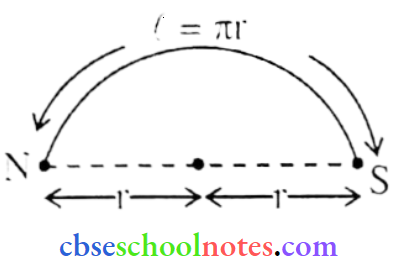
after bending
m’ = qm x 2r
⇒ \(m^{\prime}=\frac{m}{l} \times 2 \times \frac{l}{\pi}\) [ πr = l ]
∴ \(m^{\prime}=\frac{2 m}{\pi}\)
question 5. A straight steel wire of length l has magnetic moment m. If the wire is bent in the form of a semicircle, the new value of the magnetic dipole moment is.
- m
- \(\frac{\mathrm{m}}{\pi}\)
- \(\frac{m}{2}\)
- \(\frac{2 \mathrm{~m}}{\pi}\)
Answer: 4. \(\frac{2 \mathrm{~m}}{\pi}\)
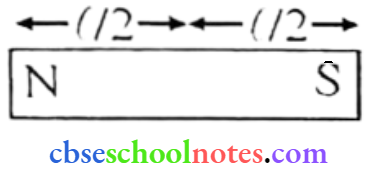
Initially
m = qm x l
⇒ \(\mathrm{m}^{\prime}=\mathrm{q}_{\mathrm{m}} \times \frac{l}{2}\)
(qm will not change)
⇒ \(\mathrm{m}^{\prime}=\frac{\mathrm{m}}{2}\)
∴ \(\vec{P}\) remains constant.
Question 6. A bar magnet of length l, pole strength ‘P’, and magnetic moment ‘\(\vec{m}\)‘ is split into two equal pieces each of length l/2. The magnetic moment and pole strength of each piece respectively ________ and ________.
- \(\vec{m}, \frac{p}{2}\)
- \(\frac{\vec{m}}{2}, p\)
- \(\frac{\vec{m}}{2}, \frac{p}{2}\)
- \(\vec{m}, p\)
Answer: 2. \(\frac{\vec{m}}{2}, p\)
Question 7. For superconductors, μr = _________.
- Zero
- Infinite
- Positive
- Negative
Answer: 1. Zero
Question 8. Which one of the following represents Curie’s law?
- \(M=\frac{C B_0}{T}\)
- \(M=\frac{C \chi}{T}\)
- \(M=\frac{C \chi}{T-T_C}\)
- \(M=\frac{C T}{B_0}\)
Answer: 1. \(M=\frac{C B_0}{T}\)
Question 9. Meissner effect is observed in _________ substance.
- Paramagnetic
- Ferromagnetic
- Superconducting
- Permanent magnetic
Answer: 3. Superconducting
Question 10. According to Gauss’s law for magnetism, the net magnetic flux through any closed surface is _________.
- Equal to ε0
- Infinite
- Zero
- Equal to μ0
Answer: 3. Zero
CBSE Class 12 Physics Chapter 5 Magnetism And Matter Assertion And Reason
For question numbers 1 to 4 two statements are given-one labelled Assertion (A) and the other labelled Reason (R). Select the correct answer to these questions from the codes (1), and (2). (3) and (4) as given below.
- Both A and R are true and R is the correct explanation of A
- Both A and R are true but R is NOT the correct explanation of A
- A is true but R is false
- A is false and R is also false
Question 1. Assertion: A bar magnet experiences a torque when placed in a magnetic field.
Reason: A bar magnet exerts a torque on itself due to its magnetic field.
Answer: 3. A is true but R is false
Question 2. Assertion: The magnetic moment of the helium atom is zero.
Reason: All the electrons are paired in helium atom orbitals.
Answer: 1. Both A and R are true and R is the correct explanation of A
Question 3. Assertion: An atom behaves as a magnetic dipole.
Reason: It is because an atom contains equal positive and negative charges.
Answer: 3. A is true but R is false
Question 4. Assertion: When the radius of a circular loop carrying current is doubled, its magnetic moment becomes four times.
Reason: Magnetic moment depends on the area of the loop.
Answer: 2. Both A and R are true but R is NOT the correct explanation of A
CBSE Class 12 Physics Chapter 5 Magnetism And Matter Short Questions And Answers
Question 1. The magnetic moment of a circular coil carrying current I, having N turns, each of radius r, is M. Find the magnetic moment of the same coil if it is unwound and rewound into a coil having 2N turns for the same current.
Answer:
M = NIA = NIπ2
According to question N(2πr) = 2N(2πr’)
⇒ \(r^{\prime}=\frac{r}{2}\)
So, New magnetic movement M’ = \((2 \mathrm{~N}) \mathrm{I} \pi\left(\frac{\mathrm{r}}{2}\right)^2=\frac{\mathrm{NI} \pi \mathrm{r}^2}{2}=\frac{\mathrm{M}}{2}\)
Question 2. The bar magnet of magnetic moment 6 J/T is aligned at 60° with a uniform external magnetic field of 0.44 T. Calculate
- The work done in turning the magnet to align its magnetic moment
- Normal to the magnetic field,
- Opposite to the magnetic field, and
- The torque on the magnet in the final orientation in case (2)
Answer:
Magnetic moment M = 6J/T
Magnetic field B = 0.44 T
(1). Work done in rotating the magnet normal to the magnetic field
W = MB(cosθ1 – cosθ2)
where θ1 =60° and θ2 = 90°
W = 6 x 0.44 (cos60°- cos90°) = 6 x 0.44 (0.5- 0) = 1 .32 J
(2). Work done in rotating the magnet opposite to the magnetic field
W = MB(cosθ1 – cosθ2)
Where θ1 =60°and θ2 = 180°
W = 6 x 0.44 (cos60°- cos 180°) = 6 x 0.44 (0.5 + 1 ) = 3.96 J
2. Torque in case (2) τ = MB sin θ2 ⇒ τ = 6 x 0.44 x sin 180° = 0
Question 3.
- An iron ring of relative permeability |.ir has windings of insulated copper wire of n turns per meter. When the current in the windings is I, find the expression for the magnetic field in the ring.
- The susceptibility of a magnetic material is 0.9853. Identify the type of magnetic material. Draw the modification of the field pattern by keeping a piece of this material in a uniform magnetic field.
Answer:
1. Consider a ring of radius r having n turns per meter, If n is the number of turns per meter, then the total number of turns in the ring = perimeter times the number of turns = 2πrn = N
Current enclosed = NI = 2πrn I.
By Ampere’s circuital law, \(\oint \vec{B} \cdot d \vec{l}=\mu_0 I\)
B x 2πr = μ0 2π rnI or B= μ0nl
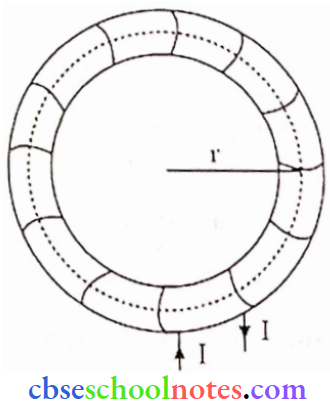
2. Given, susceptibility, χ = 0.9853.
The material is paramagnetic.
If a piece of this material is kept in a uniform magnetic field, then the field pattern gets modified as follows:
The lines of force tend to pass through the material rather than the surrounding air.

Question 4. Different diamagnetic, paramagnetic, and ferromagnetic substances based on their properties.
Answer:
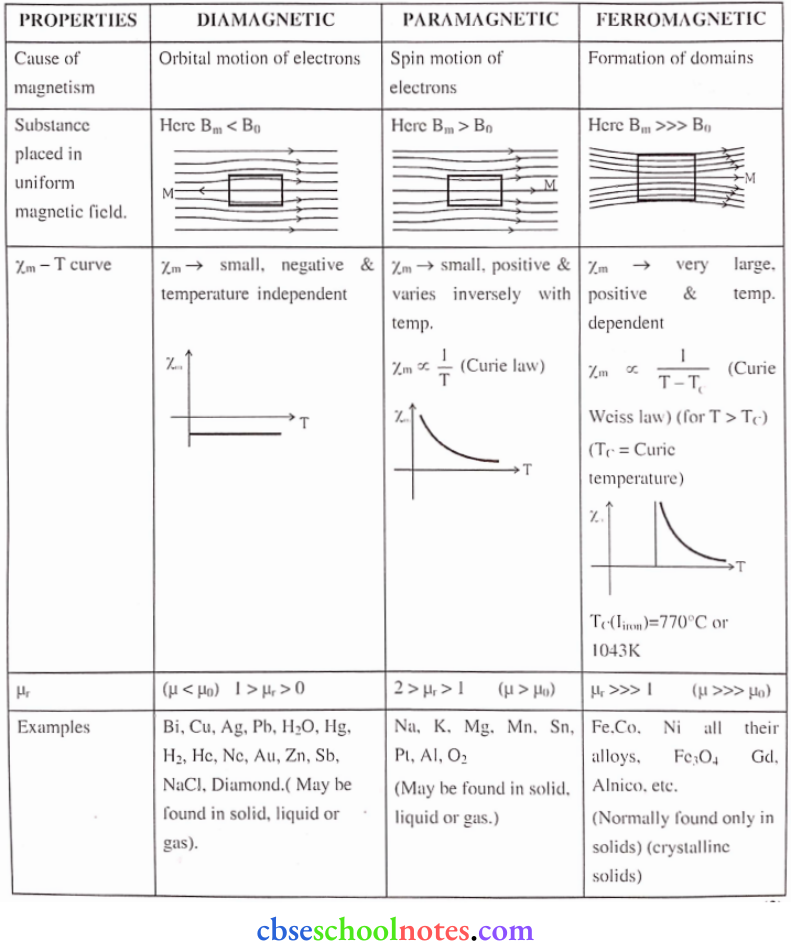
CBSE Class 12 Physics Chapter 5 Magnetism And Matter Long Questions And Answers
Question 1. When the atomic dipoles are aligned partially or fully, there is a net magnetic moment in the direction of the field in any small volume of the material. The actual magnetic field inside the material placed in a magnetic field is the sum of the applied magnetic field and the magnetic field due to magnetization. This field is called magnetic intensity (H).
H = B/μ0-M
where M is the magnetization of the material p0, is the permittivity of vacuum and B is the total magnetic field. The measure that tells us how a magnetic material responds to an external field is given by a dimensionless quantity is appropriately called the magnetic susceptibility; for a certain class of magnetic materials, the intensity of magnetization is directly proportional to the magnetic intensity.
(1). Identify the wrongly matched quantity and unit pair.
- Pole strength – A-m
- Magnetic susceptibility – dimensionless number
- Intensity of magnetisation – A/m
- Magnetic permeability- henry-m
Answer: 4. Magnetic permeability- henry-m
(2). A bar magnet has a length of 3 cm, a cross-sectional area of 2 cm2, and a magnetic moment of 3 A-m2. The intensity of magnetization of a bar magnet is
- 2 x 105 A/m
- 3 x 105 A/m
- 4 x 105 A/m
- 5 x 105 A/m
Answer: 4. 5 x 105 A/m
(3). A solenoid has a core of material with a relative permeability of 500 and its windings carry a current of A. The number of turns in the solenoid is 500 per meter. The magnetization of the material is nearly:-
- 2.5 x 103 A/m
- 2.5 x 105 A/m
- 2 x 103 A/m
- 2 x 105 A/m
Answer: 2. 2.5 x 105 A/m
(4). The relative permeability of iron is 6000. Its magnetic susceptibility is
- 5999
- 6001
- 6000 x 10-7
- 6000 x 10-7
Answer: 1. 5999
